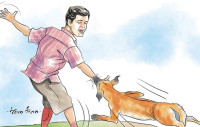Columns
Antimicrobial resistance: A pandemic long ignored
Antimicrobial resistance could gain the same global reputation as Covid-19 if it is not addressed urgently.
Ritu Amatya & Parishan Shrestha
Antimicrobials, the backbone of modern medicine, have been aptly described as the “magic bullet”. However, antimicrobial resistance (AMR)—directly responsible for 1.27 million deaths in 2019—is threatening to curb this progress. AMR occurs when a microorganism such as bacteria, viruses, and some parasites prevents an antimicrobial (such as antibiotics, antivirals, antifungals and antiparasitic agents) from working against it. If AMR were to persist, the World Health Organization (WHO) cautions, “many common infections will no longer have a cure and, once again, could kill unabated.”
This warning has been frequently echoed. An article in Lancet in January 2022 depicts a bleak future if AMR is not addressed immediately. The global burden of antimicrobial resistance (GRAM) team estimates that 4.95 million deaths were associated with AMR in 2019, including the 1.27 million deaths directly attributable to resistance. This statistic is comparable to the deaths caused by HIV/AIDs and Malaria combined in the same year.
Disrupting natural phenomenon
AMR is a natural process whereby microorganisms gradually develop resistance against the antimicrobials used against them. However, prolonged exposure to antimicrobials hastens this process. Consumption and use of these agents in livestock industries, poultry, and aquaculture account for more than half of all antimicrobials consumed globally.
Other factors, such as the unnecessary and improper use of antimicrobials, poor infection prevention and control in clinical settings, inadequate sanitation and hygiene in communities, insufficient biosafety and security in farms and lack of new antibiotic drug discovery, have also accelerated AMR worldwide.
Further, unscrupulous production, unchecked import, and sale of substandard antimicrobials, particularly in low- and middle-income countries like Nepal, have presented additional challenges to tackling AMR. Pervasive use of antimicrobials in agriculture, inappropriate disposal of antimicrobials in human and animal sectors, and waste-water discharges from pharmaceutical manufacturing sites, health facilities, farms, and slaughterhouses release resistant microorganisms into the environment.
Since antimicrobial exposure can take multiple routes, a multi-sectoral approach is required to address this issue. Moreover, resistant microorganisms and their resistant genes can pass freely between humans, animals, plants and the environment. Resistance developed in animals and the environment poses a threat to human health.
The relevant industries must therefore adopt a One Health approach, in which the human, animal, and environment sectors work together to contain AMR. The quadripartite agreement between the World Health Organization (WHO), World Organization for Animal Health (WOAH), Food and Agriculture Organization (FAO) and United Nations Environment Program (UNEP) is one example.
Nepali context
In Nepal, the impact of AMR lacks credible research evidence. However, the annual AMR data from the country’s 26 surveillance sites, 15 of which are supported by the Fleming Fund managed by Mott MacDonald and implemented by FHI 360, show a high prevalence of AMR among common bacterial pathogens. Further, an unpublished report on antimicrobial use point prevalence survey conducted by the Ministry of Health and Population, Government of Nepal, in 2021 revealed lack of standard practices related to antimicrobial use. AMR’s rise also has a socio-economic dimension fueled by policy gaps and systemic inadequacies.
There are not enough doctors in Nepal’s health care system (0.8 per 1000 population in 2019) to support the public. People living in hilly and mountainous regions are geographically challenged, and their access to the already scarce health services is limited. In addition, the healthcare service is hindered by sub-optimal facilities like the inadequate range and quality of diagnostic services, leading to public distrust in the system. Due to low national enrollment in universal health coverage, expensive healthcare services are available mostly through “out-of-pocket” payments, making patients reluctant to seek medical assistance. People often prefer to seek medical advice from local healers and pharmacies rather than consulting a medical doctor.
These practices are not just limited to rural settings; they are also common in metropolitan cities like Kathmandu, as people try to avoid the costs of consultation, investigation and treatment, long waiting times, and the fear associated with diagnosis. Unfortunately, even those who are aware of the drivers and mechanisms of AMR ignore the consequences of their actions. Patients and their relatives are known to pressure doctors into prescribing antimicrobials unnecessarily, and higher-generation and broad-spectrum antibiotics are commonly prescribed even for simple ailments.
Antimicrobial stewardship—interventions to improve and encourage the rational use of antimicrobials for better patient outcomes—is not yet practised. Some prescribers fall prey to false claims and undue influences of pharmaceutical companies, leading to irrational use.
While damaging practices and behaviour persist, AMR is growing at catastrophic levels. An example from Nepal is the emergence of extremely drug-resistant tuberculosis (XDR-TB) which is not treatable with commonly available drugs and requires costly antibiotics for longer durations.
Similarly, in a recent publication of the AMR newsletter by the National Public Health Laboratory, a remarkably high prevalence of multidrug resistant pathogens commonly responsible for community and hospital associated infections were reported. Our attitudes and practices, coupled with ineffective policies and systemic barriers, are to blame for this situation.
Way forward
AMR could gain the same global reputation as Covid-19 if it is not addressed urgently. The pandemic demonstrated the importance of global collaboration. The Access to Covid-19 Tools (ACT) accelerator brought together governments, charities, academia, and researchers to make diagnostics, treatment, and vaccines accessible to the poorest of nations. AMR also beckons a similar spirit and enthusiasm for collaborating and contributing towards its containment.
AMR should be an agenda for discussion with governments, world leaders, philanthropists, policymakers, educators, researchers, and civil society alike. Regulations on the production, import, sales, and use of antimicrobials in humans, animals, plants, and environment sectors should be strictly implemented and monitored.
It is imperative for all of us to come together to keep the “magic” working in antimicrobials. AMR is everyone’s business: Let’s pledge to use antimicrobials responsibly and preserve these precious medicines for the future.




 9.12°C Kathmandu
9.12°C Kathmandu
















